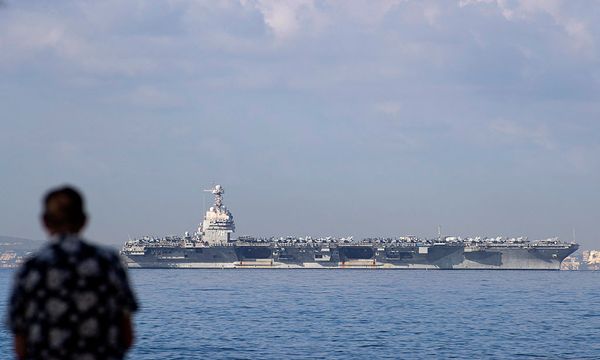
President Donald Trump’s trade policy has entered a new, chaotic phase, where structured negotiations give way to abrupt threats and legally nonbinding agreements that have left global commerce in a state of constant tension.
After several delays, Trump’s “reciprocal tariffs” took effect on Aug. 7, hitting 67 countries with tariffs ranging from 10% to 41% — but leaving others to guess what comes next.
The highest rates in the executive order target Laos and Myanmar at 40% and Syria at 41%. Canada, a top U.S. trade partner, faces a 35% tariff. India is subject to a 25% tariff in the order, but that is expected to climb to 50% on Aug. 27 citing penalties for its purchase of Russian oil.
China, a primary target of Trump’s trade agenda, has until Aug. 12 to negotiate another extension for a tariff truce or face a return to the sky-high level duties.
Four months after threatening more than 180 economies with “reciprocal tariffs,” Trump has created a landscape of rolling deadlines, ambiguous agreements and the weaponization of trade policy for noneconomic ends.
He rolled out the “Liberation Day” tariffs on April 2, then delayed them, vowing to strike roughly 90 trade deals in 90 days. In early July, Trump set the deadline back until Aug. 1, then a day before they came into effect announced another delay.
While the administration raced to strike deals with some countries, the pace has been far slower than Trump promised. Nations that announced deals with Washington have yet to sign binding documents, leaving both governments and businesses to navigate an unpredictable landscape.
Agreements with allies such as Japan and the European Union are riddled with vague or conflicting terms. Japan is contesting a new 15% U.S. tariff, and the EU’s pledge to buy $250 billion of U.S. energy each year appears unrealistic.
This erratic approach has locked the U.S. and its trading partners in what some officials are calling “perpetual negotiations.” The ceaseless uncertainty is rippling through global supply chains and is now beginning to rock the foundations of the American economy itself.
‘Perpetual negotiations’
On July 31, in a 30-minute phone call, Swiss President Karin Keller-Sutter believed she was finalizing a trade deal to shield her country from Trump’s sweeping tariffs. Instead, the outcome was shocking. Trump, incensed by a $39 billion trade deficit with the wealthy, neutral nation, dismissed Switzerland’s offer of a 10% tariff rate. Hours after the call, the White House announced it would hit Switzerland with a punitive 39% tariff, far higher than the 31% initially proposed in April.
“The woman was nice, but she didn’t want to listen,” Trump later recounted in a media interview.
The Swiss episode is a microcosm of the chaotic and deeply personal trade strategy defining Trump’s second term. His tariff-by-tweet diplomacy is creating a new era of profound uncertainty, where deals are vague, threats are personal and the economic consequences are only beginning to surface.
Foreign officials are learning that success in this new environment depends less on economic logic than on managing the president’s personality. South Korean officials, including Minister of Trade, Industry and Energy Kim Jeong-gwan, came to talks armed with a proposal they called “Masga” — Make American Shipbuilding Great Again — complete with 10 red hats modeled on Trump’s own campaign gear.
Japanese officials have adopted different tactics. Shinsuke Sugiyama, a former Japanese ambassador to the U.S., said one of the late Prime Minister Shinzo Abe’s techniques was to never contradict Trump in person. Even when Trump cited an incorrect number for Japan’s trade surplus, Abe waited for a later, more opportune moment to gently correct him.
This new world order is what Adam Tooze, a Columbia University history professor, calls a “cartoon version of protectionism.”
The Trump administration has announced agreements with the U.K., Vietnam, Indonesia, the Philippines, Japan, the European Union and South Korea. Yet the substance of these deals often appears as fleeting as a post on social media, with Trump declaring victory after a phone call, sometimes before the other leader has even been briefed on the details.
Trump’s “reciprocal tariffs” include 10% for the U.K., 15% for the EU, Japan and South Korea, 19% for Indonesia and the Philippines, and 20% for Vietnam. In exchange, partners pledged zero-tariff access for U.S. goods, huge investments in the U.S. and large purchases of American commodities — such as South Korea’s promised $100 billion in liquefied natural gas, the EU’s $750 billion in energy and Japan’s purchase of 100 aircraft.
Yet none of these is codified in binding agreements, and many commitments are disputed. For instance, Trump claimed on social media that Japan had agreed to invest $550 billion, a figure that exceeds Japan’s total annual tax revenue. Japanese officials clarified that the amount was not a direct fiscal outlay but represents the total capacity of credit, loans, and guarantees from government-affiliated financial institutions. Actual investment might only account for 1% to 2% of that total, and only if Japanese firms decide to pursue U.S.-based projects.
The confusion escalated when Japanese officials, including Economy Minister Ryosei Akazawa, publicly accused the U.S. of failing to implement the deal correctly. They say the new 15% U.S. duty is being improperly applied on top of existing tariffs, rather than replacing them as agreed, a claim echoed by Prime Minister Shigeru Ishiba.
The EU deal, announced on July 30 and hailed by Trump as “the largest agreement ever,” faces similar skepticism. While the EU agreed to a 15% U.S. tariff, its headline promise — to purchase $250 billion in American energy annually for three years — was immediately questioned by economists as the figure is nearly four times the $64.55 billion in U.S. energy the EU imported in 2024 and exceeds America’s entire annual export capacity for oil, gas and coal. The EU later stressed the pact was a “political agreement” with no legal force, and it has kept its own retaliatory tariff plans in reserve.
Analysts say the Trump administration’s focus on securing quick, headline-grabbing announcements over substantively negotiated and legally enforceable treaties ensures that none of the deals is likely to be fully realized. By leaving the details to future negotiations and operating without formal texts, the White House has created a framework for endless talks that fails to resolve underlying structural trade issues and leaves global commerce in a state of indefinite suspense.
With three and a half years left in Trump’s presidency, the world may face what some call “perpetual negotiations.”
Global supply chain shock
Among the raft of unresolved issues in the global trade standoff, a new threat emerged for global supply chains. On July 31, an executive order signed by Trump introduced a new 40% duty on goods transshipped through third countries to avoid tariffs.
The tariff will apply on any product deemed by U.S. Customs and Border Protection to have been rerouted through a third country “to evade applicable duties.” While technical details are still pending, the move is widely seen as a direct assault on Chinese products and a direct threat to Asia’s intricate supply chains.
The policy appears set to override established World Trade Organization guidelines, which classify a product as being from a third country if at least 40% of its value is added there or if it undergoes a “substantial transformation.”
The policy could prove especially damaging for manufacturing hubs in Southeast Asia. According to market analysts in the region, the new rule could be a bigger problem than the direct “reciprocal tariffs.” China’s supply chain for industries such as electronics is the most comprehensive and cost-effective in the world and forcing companies in countries such as Thailand, Vietnam and the Philippines to source components elsewhere would cause costs to soar.
Analysts say meeting a high local-content threshold, such as 50% or 60% is almost impossible for companies in the region. “If that’s the condition for getting a certificate of origin from the Trump administration,” one person familiar with the matter said, “then almost no Southeast Asian enterprise will be able to obtain one.”
At the same time, the administration’s multi-front tariff strategy is causing market chaos. Following agreements to lower auto tariffs for Japan, South Korea and the EU to 15%, U.S. carmakers collectively raised alarms. The move means that cars imported from Japan now face a lower tariff rate than cars and parts from Canada and Mexico — key suppliers for U.S.-based auto plants — which are still subject to a 25% duty.
The financial impact is already showing. General Motors said in its latest earnings report that U.S. tariff policies cost the company $1.1 billion in the second quarter, contributing to a 35.4% year-on-year plunge in net profit to $1.9 billion. Faced with this backlash from a core American industry, the Trump administration may be forced to re-evaluate its auto tariff structure.
Reevaluating the U.S. economy
While the world grapples with Trump’s policies, the U.S. economy is showing signs of strain. The August 1 jobs report delivered a shock: only 73,000 nonfarm payrolls were added in July, far below expectations. Even more troubling were the massive downward revisions for May and June, which saw a combined 258,000 jobs vanish from previous reports — the largest such revision since 1979. The data suggests the labor market has been stagnating for months, a fact masked by a stable but misleading unemployment rate.
The weak labor market is a symptom of deeper issues masked by volatile GDP figures, which have been distorted by pre-tariff stockpiling and subsequent inventory drawdowns. A more stable measure of domestic demand — final sales to private domestic purchasers — has slowed sharply, from a 3% growth rate in 2024 to 1.9% in the first quarter of 2025 and only 1.2% in the second.
Other indicators are flashing warning signs. The Institute of Supply Management’s services PMI fell to 50.1 in July, barely in expansionary territory, with new orders and employment contracting. The manufacturing PMI remained in contraction at 48. Tellingly, the few manufacturing sectors reporting growth — such as apparel and primary metals — are those heavily affected by tariffs and where the U.S. holds no clear comparative advantage.
“The U.S. government is trying to bring manufacturing back to the U.S. with tariff policies, but this will hardly increase manufacturing’s share of U.S. GDP or manufacturing employment’s share of total employment,” Brian Coulton, chief economist at Fitch Ratings, told Caixin.
Economists worry that the full impact of the tariffs has yet to hit consumers. So far, U.S. importers have absorbed most of the cost, squeezing their profit margins. But Coulton predicts this will change. “In the second half of 2025, more tariff costs will be passed on to consumers,” he said, creating a stagflationary mix of slowing growth and rising prices — a difficult challenge for the Federal Reserve.
Consequences to come
The constant threat of sweeping U.S. tariffs, marked by last-minute delays and unpredictable shifts, is creating a deep chill across the global economy, paralyzing investment decisions from Mexico to Cambodia and pushing fragile industries to the brink.
“Investment decisions and the formulation of short-, medium- and long-term strategies are difficult, if not impossible,” Enrique Dussel Peters, an economics professor at the National Autonomous University of Mexico, told Caixin.
In Cambodia, He Enjia, president of the Chinese Textile Association of Cambodia, said buyers have frozen orders pending clarity on U.S. policy. And in Indonesia, textile associations are warning of massive layoffs.
The economic damage is already being done. Coulton said that trade’s share of global GDP, which peaked in 2015, is expected to continue its decline over the next five years. According to Fitch Ratings, the tariff increases will reduce global income by about $1 trillion.
“Tariffs don’t benefit anyone; they make everyone worse off,” said Coulton. “But this is the world we are in.”
Contact reporter Han Wei (weihan@caixin.com)










